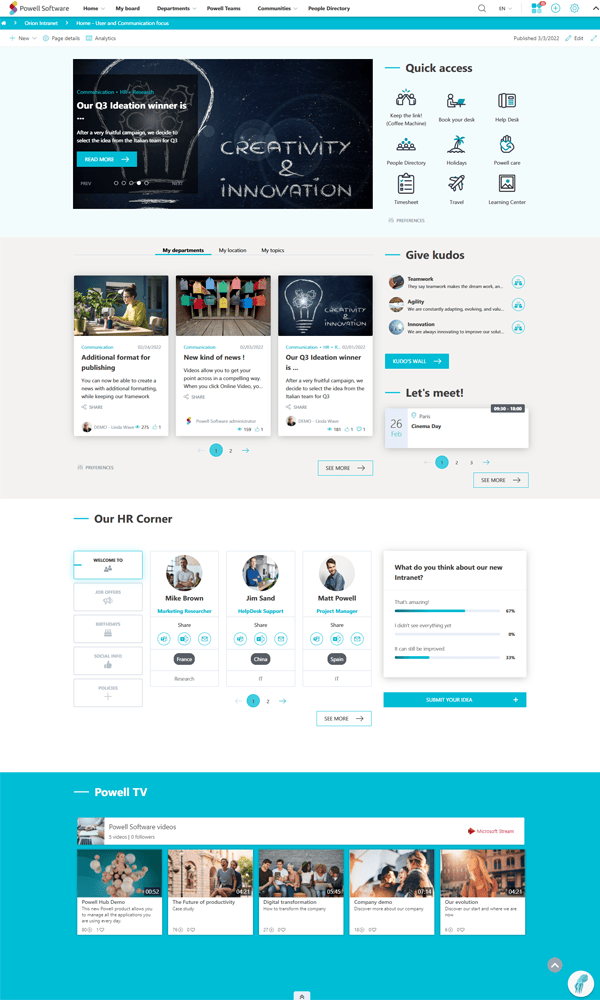But First, What is an Intranet?
Intranets are certainly not a newly invented technology. In fact, the first intranet was built around 1994. Not to be confused with the term “internet” (a global network of computers readily available to the public) an intranet is a private, internal network created for organizations to store, share, and organize information.
While the original intranets were primarily used for file storage and information sharing from senior leadership to their employees, modern versions are more focused on benefiting both companies and employees equally.
Benefit n°1: Foster Collaboration Among Employees Through Intranet Systems
Research suggests that most employees overcheck their email communication systems, with an average of 21 minutes per day wasted. Wouldn’t it be great if time could be better allocated? With an effective intranet, you can greatly reduce distractions by sharing information through the same platform where work is being performed. This means no switching between tabs because information, such as company-wide announcements, can be readily accessed.
Intranets encourage collaborative efforts among multiple team members instead of having a single communication thread between members. For instance, say your organization requests feedback on an article published through an internal blog post. With an intranet, employees can express their feedback via emoticons and comments.
Best of all, this form of collaboration typically introduces a more open line of discussion and feedback, thus improving collaboration effectiveness.
Benefit n°2: Improving productivity with an intranet system
Not only is it easier to foster better collaboration with a company intranet, but productivity also improves in many ways.
Every organization stores information, with most relying on digital technology to get the job done. However, just because the information is stored digitally does not necessarily mean it is easily accessed. In fact, most organizations struggle with information management.
A survey from M-Files 2019 Global Intelligent Information Benchmark Report found that 82% of respondents relied on multiple systems and locations to access files they were looking for while 91% said their processes could be improved if documents were easier to locate.
Implementing a company intranet means creating a centralized hub for accessing files and information, making it easier for employees to find what they need. Keep in mind, if you want to ensure the information will be more easily accessed, it’s vital to do the appropriate research before settling for an intranet provider. In other words, you’ll want to locate a system with strong search capabilities.
Benefit n°3: Streamlining Communication
As previously mentioned, an intranet better serves collaboration efforts. Now, let’s look at a few specific ways to streamline communication with a company-wide intranet.
- Company news feeds – updates are made easier through news feeds. Think about a feature like an interface that Facebook or LinkedIn offers. Users can jump on and view the latest company updates, comment, add suggestions, and everyone is always in the know.
- Employee recognition – a study in Business2Community found that 69% of employees would work harder if they felt more appreciated. With an intranet, company leaders can be more vocal with staff appreciation and highlight actions considering going “above and beyond.”
- Mobile communications – with working from home gaining popularity, it’s rare to see every single employee in the office simultaneously, which is why it’s imperative to have a system compatible with mobile devices. Bonus points if your intranet can offer push notifications and instant messaging.
The Benefits of Having a Centralized Communication Platform Within an Organization
There are numerous benefits to having a centralized communication platform, and with more employees working remotely, a central hub is becoming more of a necessity than before.
Not only does it ensure that no one misses important updates, it’s a great way to increase focus on the task at hand and ultimately create a relevant stream of information that’s easy to organize and sift through.
Depending on how you manage information within your intranet platform, tracking is simplified through instant messaging channels, meeting notes, etc. It can be a great way to keep up with specific project tasks, deadlines, and files to find exactly what you’re looking for.
Additional benefits include improved time management, document security, and better employee turnover rates.
The Impact of Efficient Communication on the Overall Success of a Company
Communication plays an important role in every aspect of an organization. Not only does it facilitate stronger relationships between employees and company leadership, but effective communication also improves the relationships that companies have with their customers. After all, employees serve as the conduit to external audiences.
When you have a system that creates a clear communication path, you will see revenues increase as expectations and goals become clearer, relationships stronger, and more opportunities available for shared ideas and innovation.
It’s important to keep in mind, however, that the act of implementing an intranet system will not foster change or create a better work culture. Rather, it should be seen as the key to the door that opens new opportunities. It’s up to organizational leaders to ensure that their intranet is optimized and actively working to improve any shortcomings.
A good way to ensure that this happens is to identify what you want to see improved prior to finding an intranet system and make sure it aligns with your goals.
Benefit n°4: Managing Information Efficiently with an Intranet System
By now, you know that providing relevant information and content to your employees is one of the many key benefits of intranets. However, all your content can be completely relevant at one point and remain stagnant until it’s irrelevant.
For this reason, it’s important to have a system within your intranet for managing data and information. This means ensuring content is set to be archived, updated, and/or deleted at appropriate times.
Not managing information appropriately could put your organization at risk. For instance, say your HR department has updated a health information policy to align with a recent federal ruling. But, the department failed to remove the older, outdated policy and an employee pulled the wrong one. Not only have they accessed (and potentially shared) incorrect health information, but your organization is at risk for noncompliance with federal law—YIKES!
Another way to ensure you choose a good intranet (where information is easily accessed) is to ensure it aligns with any collaboration suites you frequently use. If you’re not prepared to give up systems such as Google Calendar or Microsoft 365, you’ll want to ensure your intranet works well with them.
The Role of an Intranet System in Organizing and Storing Information and Data
When it comes to organizing and storing data, some say intranets will be “the future of document management.” Yet, many people remain sceptical of certain intranet offerings, such as cloud-based solutions. They wonder whether it’s really as secure as experts claim.
The truth is intranet cloud storage is one of the most effective and safe ways to maintain data. Best of all, data is quicker, easier to access, and harder to lose. In fact, one of the most beneficial parts of using a cloud-based intranet to store data is the ability to run backups to protect the data.
If you store your data locally, you risk it being un-retrievable in the event of a cyber-attack, system outage, or computer malfunction. With cloud-storage options, however, data remains safe and retrievable.
The cloud runs on a remote server instead of an on-premises server, making it accessible to employees and authorized personnel directly through the internet. With a cloud-based intranet solution, interrupted workflows usually pick up within minutes and can be continued as if nothing ever went wrong.
The Benefits of Having a Well-Structured Information Management System for an Organization
A well-established intranet is a great tool for increasing productivity, driving innovation, and accessing information faster. Now, let’s look at a few benefits of having an effective information management system that we haven’t fully addressed yet.
- Business intelligence – with new data compliance laws seeming to roll out every year, it’s incredibly important to properly manage your company’s large data sets. Let’s face it, most of us store a ton of data, regardless of the size of our business. Having a well-structured management system means having a way to collect and store data across all departments.
- Disaster recovery – when systems fail, it can be incredibly difficult to get back up and running. If you’re running an on-premises network, you could be in trouble when retrieving lost data. Your data management system should be equipped to handle data loss and minimize outages to ensure maximum productivity at all times.
- Data analytics – data analytics are more important than ever as many consumers spend their time making purchases and related decisions online rather than in person. Having a system that can quickly recognize trends and insights will automatically offer you a path to better, more informed decision-making capabilities.
Choosing the Right Intranet System for Your Organization
It’s understandable to feel some resistance when it comes time to decide if an intranet is right for you. After all, it’s a big change and can seem daunting. But, if approached correctly, with a calm and considerate mind, your intranet can serve your business in far more ways than just one.
Fortunately, Powell Software has your back. That’s why we’ve put together a step-by-step guide to help you get your digital workplace project started.
To reduce that feeling of being overwhelmed, our guide explains the different options you have for setting up an intranet while also providing you with a simplified setup manual. This handy little guide will help you answer a few common questions and hopefully accelerate the process of choosing an intranet. It will identify:
- What makes a company intranet successful?
- Intranet options for G Suite and SharePoint
- How Powell Software can assist with setup and maintenance
All that’s left to do is download our whitepaper. Follow the link, enter in some basic information (email, name, company, and phone number), and you’ll access our FREE step-by-step Intranet Guide!

